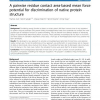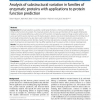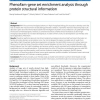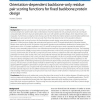BMCBI
2010
13 years 4 months ago
2010
Background: An algorithm is presented to compute a multiple structure alignment for a set of proteins and to generate a consensus (pseudo) protein which captures common substructu...
BMCBI
2010
13 years 4 months ago
2010
Background: Considering energy function to detect a correct protein fold from incorrect ones is very important for protein structure prediction and protein folding. Knowledge-base...
BMCBI
2010
13 years 4 months ago
2010
Background: Structural variations caused by a wide range of physico-chemical and biological sources directly influence the function of a protein. For enzymatic proteins, the struc...
BMCBI
2010
13 years 4 months ago
2010
Background: Partitioning of a protein into structural components, known as domains, is an important initial step in protein classification and for functional and evolutionary stud...
BMCBI
2010
13 years 4 months ago
2010
Background: We present here the recent update of AMS algorithm for identification of post-translational modification (PTM) sites in proteins based only on sequence information, us...
BMCBI
2010
13 years 4 months ago
2010
Background: Large datasets of protein interactions provide a rich resource for the discovery of Short Linear Motifs (SLiMs) that recur in unrelated proteins. However, existing met...
BMCBI
2010
13 years 4 months ago
2010
Background: The knowledge about proteins with specific interaction capacity to the protein partners is very important for the modeling of cell signaling networks. However, the exp...
BMCBI
2010
13 years 4 months ago
2010
Background: With the current technological advances in high-throughput biology, the necessity to develop tools that help to analyse the massive amount of data being generated is e...
BMCBI
2010
13 years 4 months ago
2010
Background: It is well known that most of the binding free energy of protein interaction is contributed by a few key hot spot residues. These residues are crucial for understandin...
BMCBI
2010
2010
Orientation-dependent backbone-only residue pair scoring functions for fixed backbone protein design
13 years 4 months ago
Background: Empirical scoring functions have proven useful in protein structure modeling. Most such scoring functions depend on protein side chain conformations. However, backbone...




